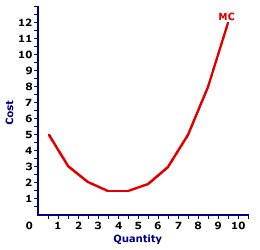
|
|
POLICY LAGS: A series of lags between the onset of an economic problem, such as business-cycle contraction, and the full impact of the policy designed to correct the problem, such as expansionary fiscal or monetary policy. Policy lags can take several years and are one of the key arguments against discretionary policies and for reliance on self correction and automatic stabilizers. Policy lags are often divided into inside lags, the time between the shock and the corrective policy, and outside lags, the time between the corrective policy and full impact on the economy.
Visit the GLOSS*arama
|
|


|

|
                           MARGINAL COST CURVE: A curve that graphically represents the relation between the marginal cost incurred by a firm in the short-run product of a good or service and the quantity of output produced. This curve is constructed to capture the relation between marginal cost and the level of output, holding other variables like technology and resource prices constant. Three related curves are average total cost curve, average variable cost curve, and average fixed cost curve. The marginal cost curve, the graphical relation between marginal cost and output, is U-shaped. Marginal cost is relatively high at small quantities of output, then as production increases, it declines, reaches a minimum value, then rises once again.This U shape is directly attributable to increasing, then decreasing marginal returns (and the law of diminishing marginal returns). As marginal product (and marginal returns) increases for relatively small output quantities, marginal cost declines. Then as marginal product (and marginal returns) decreases with the law of diminishing marginal returns for relatively large output quantities, marginal cost increases. | Marginal Cost Curve |  |
The graph presented at the right is the marginal cost curve for the short-run production of Wacky Willy Stuffed Amigos (those cute and cuddly scorpions and turtles). The quantity of Stuffed Amigos production, measured on the horizontal axis, ranges from 0 to 10 and the marginal cost incurred in the production of Stuffed Amigos, measured on the vertical axis, starts at $5, declines to $1.50, then rises again to $12.The marginal cost curve is U-shaped. For the first 4 Stuffed Amigos, marginal cost declines from $5 to a low of $1.50. However, for the production beyond 6 Stuffed Amigos, marginal cost increases. The source of this U-shaped marginal cost curve rests with increasing and decreasing marginal returns. In fact, the negatively-sloping portion of the marginal cost curve coincides exactly with increasing marginal returns in production Stage I. The positively-sloping portion of the marginal cost curve coincides exactly with decreasing marginal returns in production Stage II. The marginal cost curve takes center stage in the analysis of a firm's short-run production. In particular, a profit-maximizing firm equates the marginal revenue received from selling a good with the marginal cost of producing it. For a firm operating under perfect competition, its marginal cost curve becomes its supply curve. The marginal cost curve, because it measures the incremental opportunity cost of producing one more unit of a good plays, an important role in analyzing the efficient allocation of resources.

Recommended Citation:MARGINAL COST CURVE, AmosWEB Encyclonomic WEB*pedia, http://www.AmosWEB.com, AmosWEB LLC, 2000-2025. [Accessed: July 18, 2025].
Check Out These Related Terms... | | | | | | | | | | | | | | | | | |
Or For A Little Background... | | | | | | | | | | | | |
And For Further Study... | | | | | | | | | | | | | | | |
Search Again?
Back to the WEB*pedia
|



|

|
BLUE PLACIDOLA
[What's This?]
Today, you are likely to spend a great deal of time searching the newspaper want ads looking to buy either a wall poster commemorating the first day of winter or blue cotton balls. Be on the lookout for rusty deck screws.
Your Complete Scope
This isn't me! What am I?
|

|
|
Junk bonds are so called because they have a better than 50% chance of default, carrying a Standard & Poor's rating of CC or lower.
|

|
|
"A winner is someone who recognizes his God-given talents, works his tail off to develop them into skills, and uses those skills to accomplish his goals. " -- Larry Bird, basketball player
|

|
ARP
Average Revenue Product
|

|
|
Tell us what you think about AmosWEB. Like what you see? Have suggestions for improvements? Let us know. Click the User Feedback link.
User Feedback
|


|


